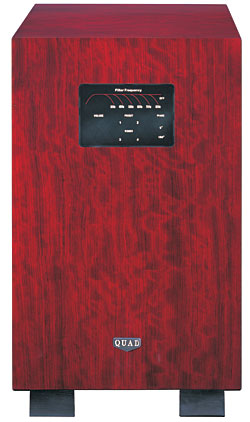Quad L-ite Soundbar Speaker System Page 2
 44 Inch Chest is a stagebound comic drama about a bunch of English gangsters who wreak vengeance on the young lover of one of their wives. A guy is tied to a chair, and people talk and talk. Harry Nilsson’s “Without You” kicks off the story to great comic effect. It called my attention to the way the soundfield spread from the 41-inch soundbar toward the more widely spaced surrounds. I drew a keystone shape in my notebook with the words “feels wide” in the middle. The L-ite LCR makes no attempt to broaden its three front channels with side-mounted tweeters or psychoacoustic magic, so it’s limited by its 41-inch width. If you sit close enough, that probably won’t matter. It’s worth noting that most soundbars are designed for intimate settings or limited seating arrangements.
44 Inch Chest is a stagebound comic drama about a bunch of English gangsters who wreak vengeance on the young lover of one of their wives. A guy is tied to a chair, and people talk and talk. Harry Nilsson’s “Without You” kicks off the story to great comic effect. It called my attention to the way the soundfield spread from the 41-inch soundbar toward the more widely spaced surrounds. I drew a keystone shape in my notebook with the words “feels wide” in the middle. The L-ite LCR makes no attempt to broaden its three front channels with side-mounted tweeters or psychoacoustic magic, so it’s limited by its 41-inch width. If you sit close enough, that probably won’t matter. It’s worth noting that most soundbars are designed for intimate settings or limited seating arrangements.
I Found That Essence Rare
Gambensonaten is a treat for those of us who regard Johann Sebastian Bach as the gold standard in music. The Sony Classics CD, with cellist Jan Vogler and pianist Martin Stadtfeld, combines sonatas written for the two instruments with choral preludes arranged for them. In the stereo mix, the cello sits slightly ahead of the piano. Adapted from stereo to the Dolby Pro Logic II Music mode, the cello remains focused, while the piano—evidently recorded with a lot of ambience-rich out-of-phase information—gets too diffused. I prefer the two-channel approach, so I shut down the soundbar’s center drivers as well as the surround speakers and depended only on the soundbar’s left and right channels. Even with some of its drivers disabled, the L-ite soundbar—according to my notes—produced “a soundstage so spatially rich that it could be mistaken for surround.” It was “that rarity—a music-worthy soundbar.”
I was trawling through my Byrds CDs as I was writing this review. The iconic title track of Turn! Turn! Turn!—in mono, unlike most of the other songs on the album—felt comfortingly like AM car radio when the soundbar’s left and right drivers pumped it out. That’s how it was intended to sound. I switched to a later item in the catalogue, Fifth Dimension, which is wholly in stereo. At the time, it seemed like a good idea to play “Eight Miles High” in DPLII Music mode, but the execution lagged the concept. There just wasn’t enough coherent ambience in the source material to support good matrixed surround, and I was annoyed by bits of percussion flotsam that flung too far toward the surrounds. I ended up back in stereo. The upside of playing this vintage 1960s two-channel recording on a soundbar was that the width of the soundbar helpfully constricted the ping-pong mix, which often shoves guitars and vocals to the far sides.

Jazz Impressions of Black Orpheus by the Vince Guaraldi Trio arrived on flea-market vinyl, the poor man’s high-resolution medium of choice. Although Guaraldi was more widely known for his Charlie Brown theme music, this 1962 album—especially “Cast Your Fate to the Wind”—was a hit in its time. It introduced the American public to the then-unknown pleasures of the samba. I wondered if the combined warmth of the Quads and my tube phono preamp would be too much of a good thing. The answer was no. They complemented each other beautifully and offered a laid-back listening experience that would probably be enough in itself to sell people on this speaker system. The LP also survived rechanneling in DPLII. The drums defocused slightly—but not unpleasantly—and everything else emerged in good proportions.
The Quad L-ite LCR, Satellite, and Subwoofer are great products no matter where you move the goalposts. By the minimal standards of soundbar products, they are champions. Even judged by the same standards as any other speaker type, they deliver the audio fundamentals with panache, combining the soundbar’s lush midrange with the subwoofer’s weight and power. The sub’s remote-control adjustability makes the package even more attractive—as it should, since it accounts for nearly half the cost. At more than two thousand bucks, this system isn’t cheap by soundbar standards, but it earns its price tag and then some. Put it on your short list of high-performance soundbar systems.

- Log in or register to post comments






























































